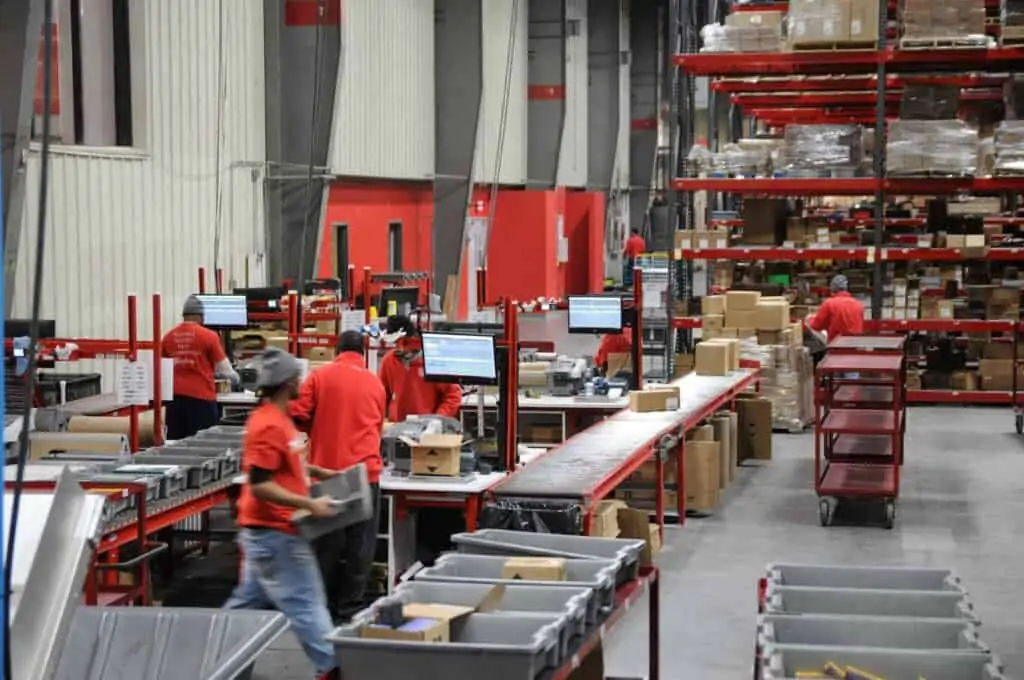Standard shipping is the most commonly used shipping option in eCommerce fulfillment. Getting the most speed out of standard shipping while keeping shipping costs down is a sweet spot that many online retailers struggle to hit. In this guide, we’ll explain what you need to know about standard shipping and how third-party fulfillment can help make it work for you and your customers.

Standard shipping definition
Standard shipping is the default shipping option in online retail. It is the slowest and least expensive (or free) shipping option at checkout. It is also commonly known as ground shipping, after the basic shipping services offered by the major carriers.
Why eCommerce companies must offer a range of shipping options
While a standard shipping option is essential, your company should offer at least three eCommerce shipping options. Customers who need an item in a hurry, perhaps before leaving on a trip or in time for a birthday, will pay extra for expedited shipping and might shop elsewhere if you don’t offer it as an option.
If you outsource your fulfillment to a 3PL, you can gain access to more shipping options. At Red Stag Fulfillment, we ship millions of packages each year. That allows us to work with a range of carriers and get the best deals on shipping for our clients.

Standard domestic shipping services
There are several options for offering basic shipping to your customers within the U.S. For small businesses or those handling fulfillment in-house, it might make sense to pick one carrier to use for all or most of your eCommerce shipping. The higher the volume you ship, the better the commercial rates you can get. If you work with a fulfillment center, you may be able to take advantage of discounts and carrier relationships through your 3PL.
Here are the three most basic standard shipping services.
FedEx Ground
FedEx Ground is the least expensive FedEx service. Deliveries within the contiguous U.S. states take between one and five days. To reach Alaska and Hawaii, allow three to seven days. If you ship orders to Canada, you can use FedEx International Ground as an economical international shipping option.
FedEx accepts packages that weigh up to 150 pounds for ground delivery as long as they fall within its size limits.
UPS Ground
UPS Ground standard shipping takes 1-5 business days, delivering to all 50 states and Puerto Rico. It has the same weight limit as FedEx, and packages can be no longer than 108 inches on the longest side.
Your shipping times for either UPS or FedEx Ground will depend on the distance between the warehouse and the customer. Using a centrally-located fulfillment warehouse can save you time and money on ground shipping.
USPS standard shipping options
USPS Priority Mail service is standard for boxes that weigh more than one pound. While this service may cost more than shipping the same package by FedEx or UPS ground, it will get your package to your customer in one to three business days, no matter how far you’re shipping. Priority Mail can be an excellent option for shipping orders across the country.
The U.S. Postal Service also offers lower-cost ground shipping services for packages up to 70 pounds, with a delivery window of two to eight days.

How does selling on Amazon affect shipping options?
If you sell on Amazon (and who doesn’t?), you can use Fulfillment by Amazon (FBA) to gain access to Amazon’s fulfillment and delivery services, including Prime 2-day shipping. If you use a different option for Amazon order fulfillment, you should be aware that Amazon shoppers expect fast delivery options and be prepared to provide them. At the end of this article, we have suggestions for strategies to get orders out fast without overspending on shipping.
How to think about standard shipping costs in eCommerce
There are three ways to charge customers for standard shipping on eCommerce orders:
- Charge the actual cost of shipping, calculated at checkout.
- Set a flat rate for shipping, no matter how much or little someone orders.
- Offer free standard shipping.
Obviously, free shipping is a popular choice with consumers. To make it cost-effective and ensure their margins are big enough to cover the cost of shipping, many retailers offer free shipping on orders over a certain amount. Or, consider offering free shipping as a perk to VIP shoppers or as a special promotion available at limited times.
Flat-rate shipping is another way to reward shoppers for making bigger purchases. For example, paying $5 for shipping can seem steep if someone is buying a single item for $10. But if they can get four more items without paying extra for shipping, that’s an excellent deal.
Charging the actual cost for standard shipping is a perfectly acceptable option. You can pass on shipping costs to your customers without hurting sales if you keep costs low. If your minimum shipping costs account for a significant amount of the total order price, you will lose sales, so it’s essential to deploy smart shipping strategies.

What about packages that need special handling?
You can’t send certain items with standard or ground shipping. Packages that weigh more than 150 pounds or exceed the length or girth limits set by delivery services will be subject to overweight or oversize charges, increasing the shipping cost.
Another shipping method for large eCommerce packages is residential freight. Many freight companies can deliver items such as furniture, exercise equipment, bikes, car parts, or bulk palletized shipments to residential addresses. Expect to pay more for residential freight than commercial freight, and time in transit will be longer than standard shipping. Still, this option can help keep shipping costs low and allow you to sell oversized merchandise online.
![How to Ship Large Boxes and Oversized Packages Affordably and Safely [make Hubspot CTA]](https://no-cache.hubspot.com/cta/default/4623941/62e6db03-00a3-4912-93e1-f028d1286783.png)
How to offer fast delivery without expedited shipping costs
Free or low-cost standard shipping is an excellent option, but it’s essential to pair that with fast delivery. Getting orders to your customers quickly without incurring extra shipping charges is a signature challenge of modern eCommerce and often what divides successful companies from struggling ones.
Here are two strategies to help you provide fast, cheap ground shipping.

Same-day order fulfillment
To understand same-day order fulfillment, let’s look at an example. Suppose it takes two days for a carrier to deliver from your warehouse to a customer. If the order doesn’t leave the warehouse until two days after the customer places it, you’ve effectively doubled delivery time from two days to four. As far as your customer is concerned, every extra day they have to wait for their package is a shipping delay.
Same-day order fulfillment ensures your products leave the warehouse the same day your customer clicks “Buy.” At Red Stag Fulfillment, we make this possible—helping you avoid warehouse delays and speed up delivery without increasing shipping costs.

Well-placed fulfillment centers
Another excellent strategy that reduces both time in transit and shipping costs is to place your warehouses closer to your customers. When you work with a 3PL, you can choose warehouse locations that offer fast delivery to the regions where you log the most sales.
Amazon can offer next-day and even same-day delivery because it has many warehouses throughout the U.S., particularly near large population centers. When you use FBA, you may get some of the advantages of Amazon’s broad warehouse network. However, the more warehouses you place inventory into, the more stock you must carry.
The ideal solution is having the smallest number of fulfillment centers that can reach the largest number of consumers. For example, Red Stag Fulfillment’s warehouses in Tennessee and Utah can ship to 96% of U.S. addresses in two days or less.

3 ways Red Stag Fulfillment reduces standard shipping costs
When you’re looking for the best standard shipping solution, your fulfillment partner is a crucial ally. Here are three ways that Red Stag Fulfillment helps our clients save on shipping.
- Shipping discounts
As a volume shipper, Red Stag negotiates favorable rates with the major shipping companies, and we pass on shipping discounts to our clients. - Flexible carrier selection
RSF’s warehouse management software allows us to select the best carrier for each package, if you choose. For instance, if UPS can get an order to one customer faster and FedEx is the cheapest way to ship to another address, we choose the optimal carrier for each order. - Favorable DIM factors
A DIM factor is a number used to determine dimensional weight charges for oversized packages. As the industry leader in oversized and bulky shipping, Red Stag Fulfillment has secured favorable DIM factors to reduce the cost of shipping our clients’ oversized orders.
Whatever your shipping questions, reach out to Red Stag to see how we can help.

More about eCommerce shipping:






